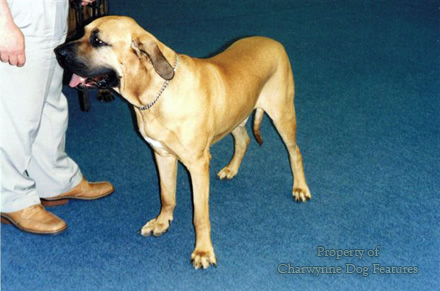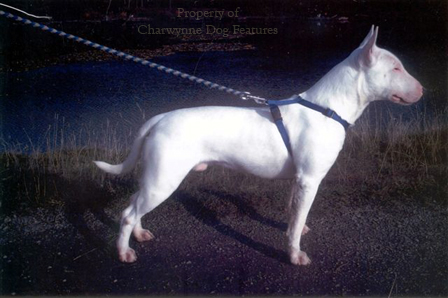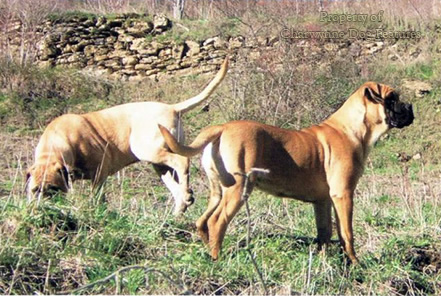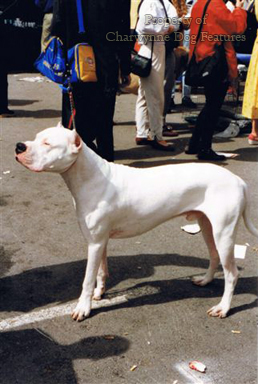572 Alauntes
ALAUNTES: HOUNDS OF HORSEMEN
by David Hancock
 From time to time in Countryman's Weekly you see 'Alaunts' offered for sale and, I am told, they are re-creations of ancient hunting dogs, ranging from 140lb specimens down to the lighter bull-lurcher type, bred by enthusiasts. Lyndon Ingles of Tredegar is one such, with strong-headed yet extremely athletic Alaunts. For any type to be correctly named an Alaunt, it is vitally important to keep in mind a number of historical facts: firstly, that Alaunts didn't form a breed but a function. Secondly, they had to run with horses, which rules out heavy cloddy dogs with too much bone and bulk. Thirdly, they were hounds not powerful watchdogs; they were hunting dogs not huge yard dogs. Any fool can describe his dogs as Alaunts but if historical accuracy is desired and the name used honestly, then a canine athlete, a running dog, is the goal.
From time to time in Countryman's Weekly you see 'Alaunts' offered for sale and, I am told, they are re-creations of ancient hunting dogs, ranging from 140lb specimens down to the lighter bull-lurcher type, bred by enthusiasts. Lyndon Ingles of Tredegar is one such, with strong-headed yet extremely athletic Alaunts. For any type to be correctly named an Alaunt, it is vitally important to keep in mind a number of historical facts: firstly, that Alaunts didn't form a breed but a function. Secondly, they had to run with horses, which rules out heavy cloddy dogs with too much bone and bulk. Thirdly, they were hounds not powerful watchdogs; they were hunting dogs not huge yard dogs. Any fool can describe his dogs as Alaunts but if historical accuracy is desired and the name used honestly, then a canine athlete, a running dog, is the goal. 
The Alaunts were the dogs of the Alans. The Alans were astounding horsemen, so rated as to provide the cavalry for the Roman legions. In a well known inscription, found at Apta on the Durance, the Emperor Hadrian praises and commemorates his 'Borysthenes Alanus Caesareus Veredus' that 'flew' with him over swamps and hills in Tuscany, as he hunted the wild boar. The Romans hunted the wild boar with hunting mastiffs; the Alans would have provided hunting mastiffs as well as horses, their renowned Alaunts. The governors of Milan were once commended 'because...there have sprung up in our region noble Destriers (the war horses of medieval knights) which are held in high estimation. They also reared Alanian dogs of high stature and wonderful courage.' Chaucer did of course refer to 'Alauns' as big as steers; the type was evidently acknowledged here then.
As the cavalry for the Roman legions, the Alans have left their mark in Britain. The Avon in Hampshire was once called the Alaun, as was the Alne in Northumberland. Allaway in Scotland comes from this source too. In his very informative The Master of Game of 1410, the renowned hunter Gaston de Foix's words on French dogs are reworked by Edward, second Duke of York. He describes the Alaunt as a hound 'better shaped and stronger for to do harm than any other beast'; he made a distinction between mastiffs and Alaunts. He regarded the latter as seizing dogs, the former as big running mastiffs, for use in the chase. De Foix was the greatest hunter of his time, maintaining a kennel of over a thousand sporting dogs. He would not have blurred mastiffs with Alaunts, he used them in different ways. They had different functions.
Three types of Alaunts were listed: alauntes 'gentle' (made and shaped like a sighthound but with a stronger shorter wider head), alauntes veutreres or hunting mastiffs and alauntes of the butcheries or great butchers' hounds, the latter being the catch-dogs, seizers or pinning and holding dogs. Contemporary equivalents would be, in that order: a smaller version of the Great Dane, a Cane Corso or a Boerboel, and the Bulldog (of old). De Foix wrote that 'the good alaunte should run as fast as a greyhound, and any beast that he can catch he should hold'. The alauntes veutreres were employed as boarhounds, but as a seizer after the alauntes gentle had hunted down the quarry. The three types were complementary, supporting each other as specialist hounds.
The Alans, a steppe nomad people, settled in a number of countries, including Spain in 406 AD. Spain in the Middle Ages produced the best Alauntes. The war-dogs of the conquistadors were Alauntes, used extensively to subdue natives in the Spanish Americas. Chroniclers referred to them as mastins, alanos and lebrels, the latter strong-headed sighthounds, rather like a bull-lurcher. The Spanish still have their perro de presa (holding dog), the Canary Dog and their Alano. The Portuguese took theirs as filas (holding dogs) to Brazil, to found today's Fila Brasileiro, or holding dog of Brazil. The Cuban Mastiff, the Borinquen Mastiff of Puerto Rico and the restored Perro Cimarron of Uruguay are embraced by this type. 
No depiction of an Alaunt shows an over-boned cloddy heavily-built short-faced yard-dog. They show, not the American Bulldog conformation, but much more apparently the Rhodesian Ridgeback/ Dogo Argentino style: just over two feet high, with tuck-up, strong-headed with breadth right down to the nose, but never a Bulldog head, a powerfully muscled body, short-haired and with small drop ears, essentially a real canine athlete. Such a dog had to be able to clear obstacles, keep up with the mounted hunters and pull down its quarry, usually boar or stag. Eventually, as the par force hunt developed into less of a steeplechase, the seizers were held by their collars until needed, and referred to as bandogges. But for all their power in the charge, such dogs had to accompany the hunt, which demanded stamina, and clear fallen logs or undergrowth at speed, which demanded explosive power. One day the kennel clubs of the world will accept that mastiffs were heavy hounds; even the international body, the FCI, groups them as 'Molossers and Dogues', embracing mountain dogs and the mastiff breeds.
The recognition of breeds and the subsequent alteration of them by show ring fanciers has led the general public to assume that the Bulldog was always squat, muzzleless and unathletic and the Mastiff huge, bulky and unathletic; not so. The Mastiff's true ancestors were heavy hounds not mountain dogs; the Bulldog's real ancestors were alauntes of the butcheries not pug-mastiffs.
Perhaps the re-creation of Alauntes will give us impressive canine athletes, like Lyndon Ingles's dogs, worthy of their heritage and name. But if they are bred like over-boned, needlessly-bulky short-faced yard-dogs, they will have no claim to their title whatsoever. For any dog to be called after the renowned Alaunts, it would have to be very special, a very special canine athlete, capable of great sprinting power and immense gripping strength from its jaw and neck construction. A number of our sporting breeds of dog deserve a comparable restoration to their true form; who can foretell a future world in which they won't be needed? Feral hogs are a huge problem in the Antipodes; they are best caught by a brave, powerful hound – like an Alaunt!